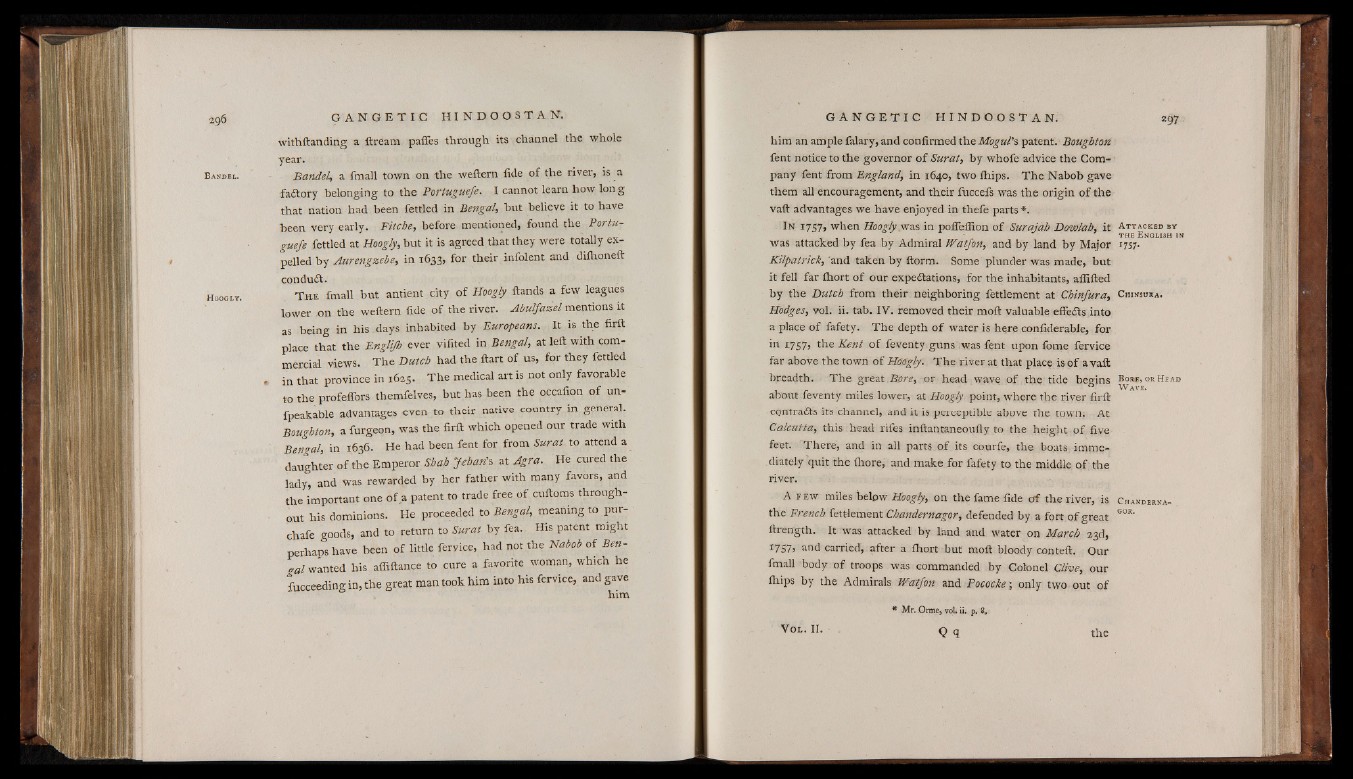
withftanding a ifaream pafles through its channel the whole
year.
B a n d e i ,. BandeL, a fmall town on the weftern fide of the river, is a
:fa£tory belonging to the Portuguese. I cannot learn how Ion g
that nation had been fettled in Bengal, but believe it to have
been very early. Fitcbe, before mentioned, found the Portu-
guefe fettled at Hoogly, but it is agreed that they were totally expelled
by Aurengzebe, in 1633, for their infolent and diihoneft
conduit.
H o o g l y . T h e fmall but antient city of Hoogly ftands a few leagues
lower on the weftern fide of the river. Abulfazel mentions it
as being in his days inhabited by Europeans. It is the firft
place that the Fnglijh ever vilited in Bengal, at left with commercial
views. The Hutch had the ftart of us, for they fettled
. in that province in 1625. The medical art is not only favorable
to the profeffors themfelves, but has been the occafion of un-
fpeakable advantages even to their native country in general.
Boughton, a furgeon, was the firft which opened our trade with
Bengal, in 1636. He had been fent for from Surat to attend a
daughter of the Emperor Shah Jehan’s at Agra. He cured the
lady, and was rewarded by her father with many favors, and
the important one o f a patent to trade free o f cuftoms throughput
his dominions. He proceeded to Bengal, meaning to pur-
chafe goods, and to return to Surat by fea. His patent might
perhaps have been of little fervice, had not the Nabob of Bengal
wanted his afliftance to cure a favorite woman, which he
fucceeding in, the great man took him into his fervice, and gave
him an ample falary, and confirmed the Mogul’s patent. Boughton
fent notice to the governor o f Surat, by whofe advice the Company
fent from England, in 1640, two fhips. The Nabob gave
them all encouragement, and their fuccefs was the origin of the
vaft advantages we have enjoyed in thefe parts *.
In 1757, when Hoogly was in poflefiion o f Surajab Dowlab, i t A t t a c k e d b y
t h e E n g l i s h in
was attacked by fea by Admiral Watfon, and by land by Major 1757.
Kilpatrick, and taken by ftorm. Some plunder was made, but
it fell far ihort of our expectations, for the inhabitants, aflifted
by the Hutch from their neighboring fettlement at Chinfura, C h i n s u r a .
Hodges, vol. ii. tab. IV. removed their moft valuable effeits into
a place of fafety. The depth of water is hqre confiderable, for
in 1757) the Kent o f feventy guns was fent upon fome fervice
far above the town of Hoogly'.. The river at that place is o f avail
breadth. The great Bore, or head wave o f the tide begins Bo*«, or H e a d
. ..................... " W a v e .
about feventy miles lower, at Hoogly point, where the river firft
contracts its channel, and it is perceptible above the town; At
Calcutta, this'head rifes inftantaneoufly to the height of five
feet. There, and in all parts of its courfe, the boats immediately
quit the ihore, and make for fafety to the middle of the
river.
A f e w miles below Hoogly, on the fame fide of the river, is C handernathe
French fettlement Cbandernagor, defended by a fort o f great °0R'
llrength. It was attacked by land and water on March 23d,
1757, and carried, after a ihort but moft bloody conteft. Our
fmall body o f troops was commanded by Colonel Clive, our
ihips by the Admirals Watfon and Pococke; only two out of
* Mr. .Orme, vo!. ii. p. S.
Q q